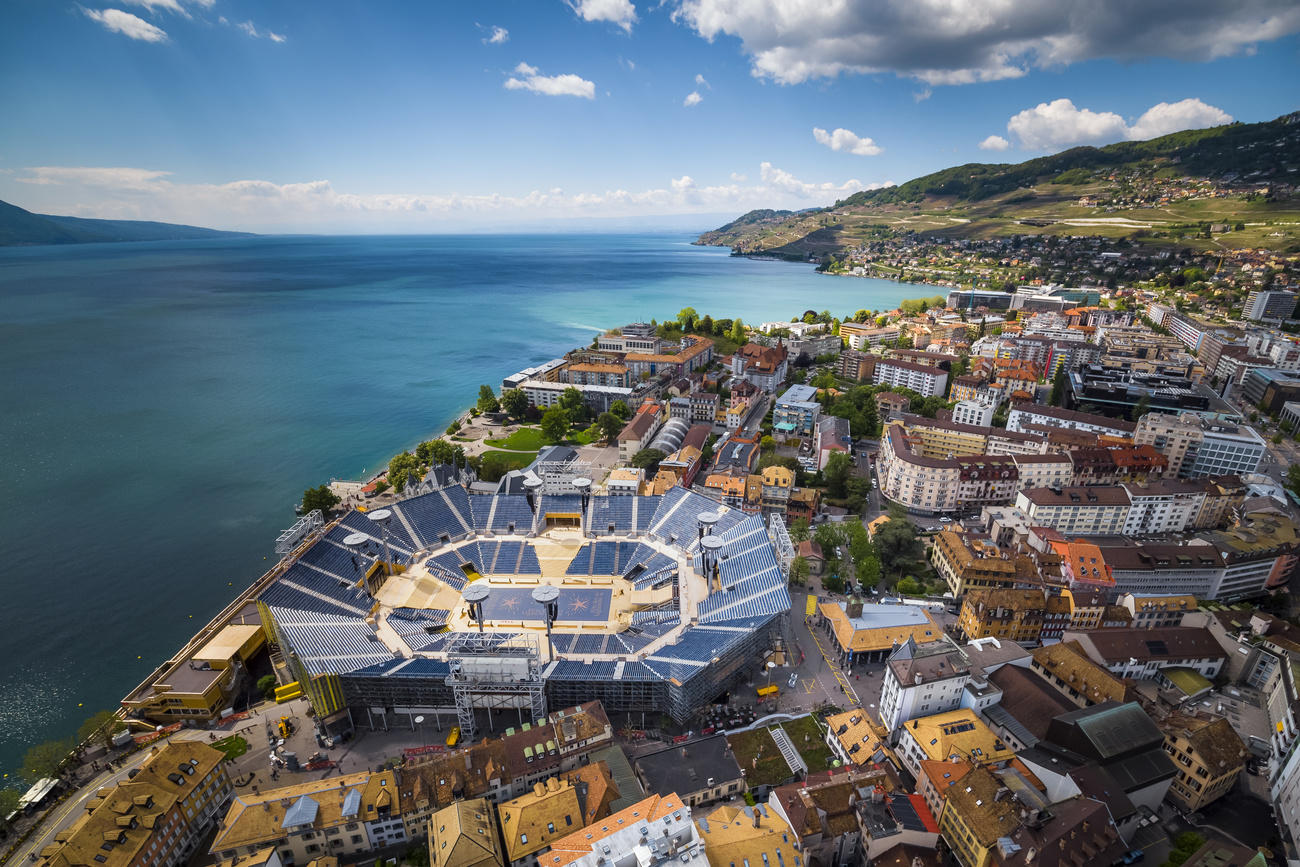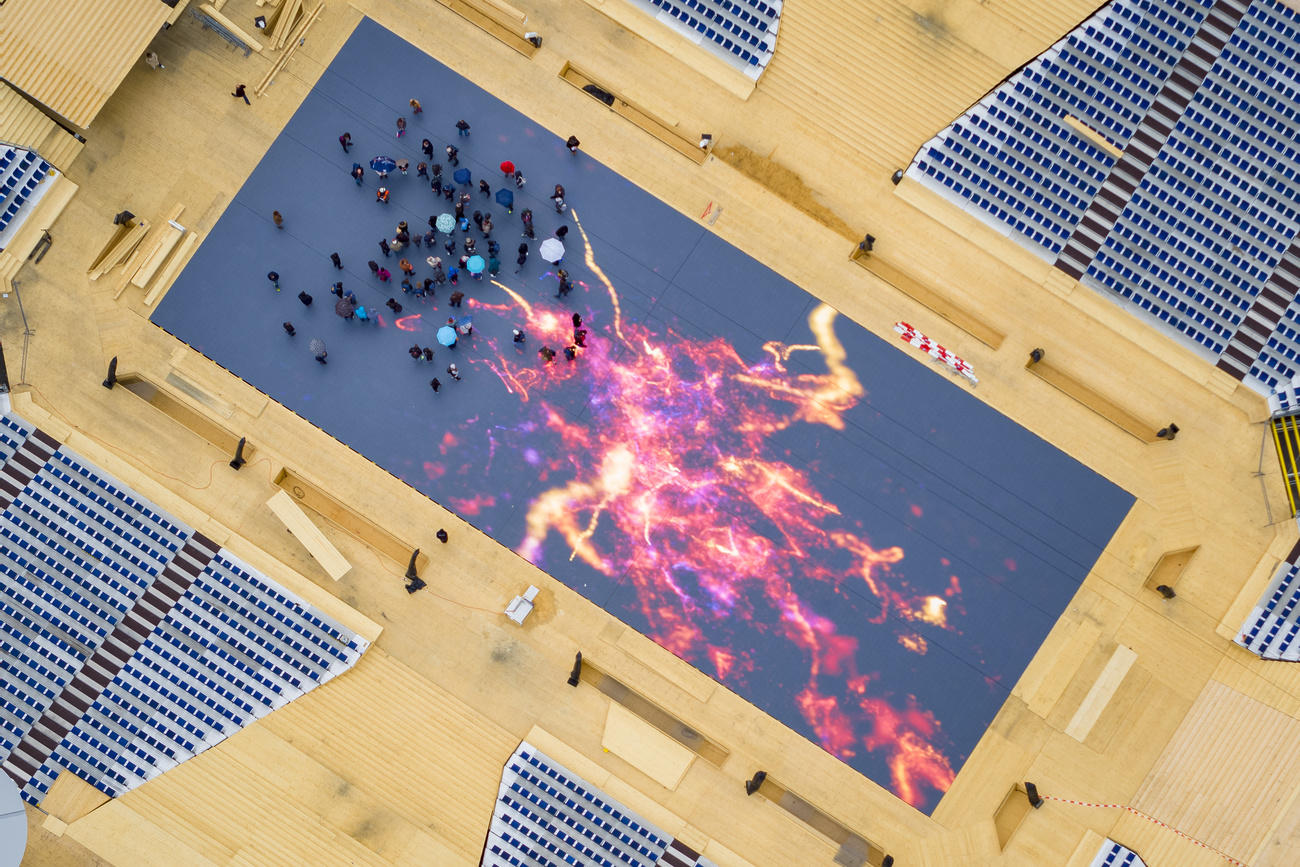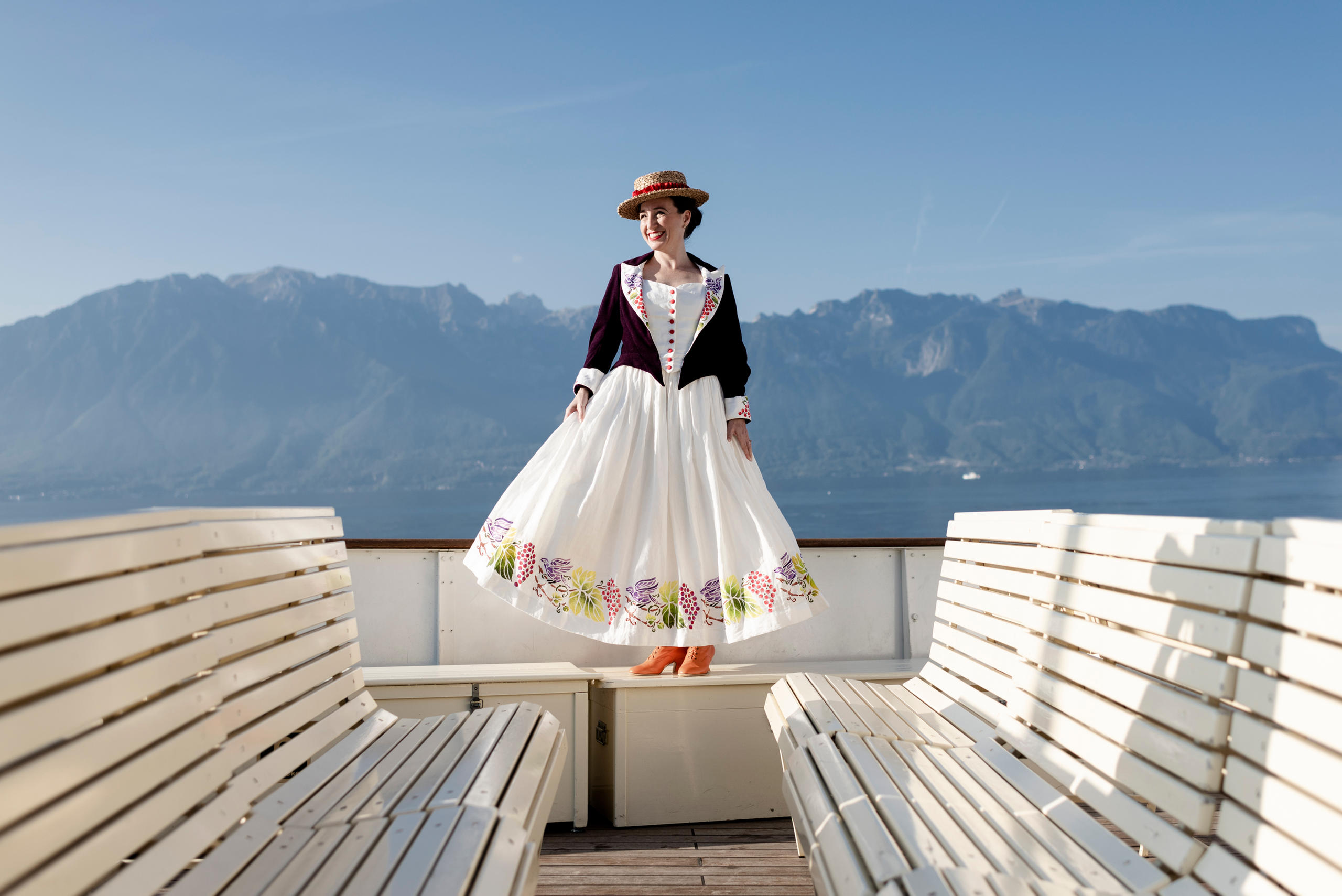
How Vevey organises its once-in-a-generation winegrowers’ festival

Throwing the Fête des Vignerons, a traditional winegrowers’ festival held roughly every 20 years in the lakeside town of Vevey, is no small endeavour. The colourful local pageant, set to attract a million visitors, has grown into a Rio carnival-scale operation with huge organisational challenges.
Like a gigantic spacecraft that has descended from the heavens, a 20,000-seat open-air arena dominates the market square in Vevey, located on the shores of Lake Geneva. Decorated in red, yellow, green and brown, the stadium is the most visible element of the forthcoming Fête des VigneronsExternal link, a four-times-a-century festival set to transform the small town.
From July 18 to August 11, one million people are expected to flock to this year’s Fête, which celebrates the viticulture traditions of the Lavaux and Chablais wine regions. From its humble beginnings as an annual street parade in the 17th and 18th centuries, the private celebration organised by the local winegrowers’ guild, the Confrérie des VigneronsExternal link, has metamorphosed into a unique three-week-long festival and street party that mixes traditional song, dance and theatre.
Daily two-hour shows staged by Daniele Finzi Pasca, the director of the Sochi and Turin Olympic ceremonies, will feature over 7,000 local actors, singers and musicians – almost all volunteers. Afterwards, the costumed spectacle and traditional themes – many identical to those first celebrated over 200 years ago – will spill out into the town’s streets and bars.

More
A journey back in time at the Fête des Vignerons
More complexity
Putting on such historic festivities does not come cheap. As the private event has expanded over the years, so has its budget. It will cost CHF100 million ($101 million) this year, almost double that of the previous edition in 1999.
“The festival has always been gigantic. The building site in the 18th and 19th centuries took six months. This year it also took us six months, but we’ve increased in complexity,” explains Frédéric Hohl, the festival’s executive director.
The spiralling costs are partly due to more sophisticated production techniques.
“In 1999, there was one stage. But we now have five in one single arena. That means five different light and sound setups, and five times as many technicians,” says Hohl.
Constructing the arena cost CHF13 million, while the lights and sound alone cost CHF12 million.

Eight 32-metre-high pylons fitted with 400 speakers are dotted throughout the stadium. It also has the world’s biggest “LED floor”, a 1,000-square-metre interactive floor system onto which images can be projected, five times bigger than the ones used at the US Super Bowl and Eurovision Song Contest.
Going green
This year, the organisers have also had to deal with additional environmental demands. Around 95% of the material used during the festival is recyclable, or can be re-sold or re-used. Other special measures have been taken to preserve the ecosystem in Lake Geneva.
“In 1999, you just had to send a letter to the cantonal water service to obtain permission to build a terrace on the lake,” festival construction manager Daniel Willi told the 24Heures newspaper. “This time, we had to do a public inquiry and an impact study. For that, divers were sent to the site to observe the aquatic fauna and flora beforehand.”

Underwater stones that had to be moved were carefully recorded, and will have to be put back at the end of the festival. Together, these green measures are costing around CHF2-3 million.
Renting the streets
The complexity of organising the 12th edition, initiated in 2009, was reflected in the long, tricky negotiations between the Confrérie and the Vevey authorities last year. They eventually hammered out an agreement under which the guild agreed to pay CHF3 million to rent the market square and other public property and services, and to compensate local businesses. It must also invest heavily in security measures.
“The expectations of the local authorities and security specialists are much greater than 20 years ago due to things going on around the world like terrorist attacks. It’s been a total paradigm shift, which makes things more expensive,” says François Margot, the Abbé-President of the Confrérie.

Everything adds up, whether it’s hiring engineers, renting 1,000 portable toilets or paying for the 6,000 costumes that have been produced in Italy.
“We estimated a 25% increase in costs compared to 20 years ago for everything,” said Hohl.
Volunteers
One budget line under control is personnel costs. These have been kept to a minimum, as most of the 10,000 workers and show participants are unpaid volunteers – the festival’s lifeblood. But finding helpers with the right skills has been another challenge.
The festival still has a strong pull among local volunteers, but the organisers say people seem to be less available than in the past, and local companies are less willing to let managers take time off to help.
“In 1999, Nestlé and certain local banks gave managers an afternoon off per week to work for the festival. That was their contribution to the festival, but policies have changed in 20 years,” says Sabine Carruzzo, the Confrérie’s secretary general.
“It’s become a lot more professional, as lots of jobs which were previously held by volunteers have been handed to professionals, especially as people now have less time.”

Victim of its own success
To finance the expanded festival – while aiming for a tidy CHF6 million profit to allow the guild to continue to exist for the next 20 years – the organisers have been forced to put on one more week of shows and sell 110,000 more tickets to cover the extra costs. Corporate sponsors, like Nestlé and the airline Swiss, will pick up around 20% of the total bill.
This year, individual show days have been allocated to the Swiss cantons, each of which will send its own costumed delegations. The festival has been marketed heavily in German-speaking Switzerland and abroad – especially the United States, France and Germany.
“If you were to present our business plan to any financier, they would say ‘no, no, don’t do that, you’re crazy’,” Hohl laughs.
The 12th edition of the Fête des Vignerons takes place from July 18 to August 11. Tickets for one of the 20 shows in the 20,000-seat outdoor arena vary between CHF79-359; around 70% of tickets have been sold so far. Over 5,500 actors, 900 singers and 240 musicians are taking part in the two-hour show.
The event has a budget of CHF100 million. Around 40,000 people are expected to attend every day – 19,500 spectators in the arena, 10,000 volunteers and other workers and 10,000 visitors. In 2016, the festival was awarded Unesco heritage status.

In compliance with the JTI standards
More: SWI swissinfo.ch certified by the Journalism Trust Initiative





























You can find an overview of ongoing debates with our journalists here . Please join us!
If you want to start a conversation about a topic raised in this article or want to report factual errors, email us at english@swissinfo.ch.